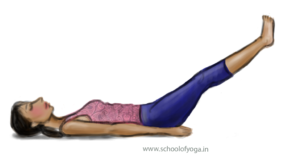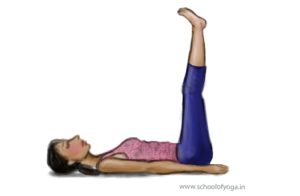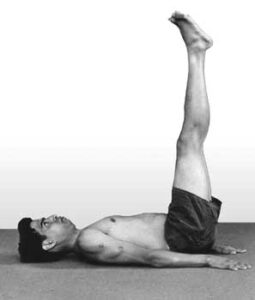What is arda-halāsana (Semi-plow pose)?
Arda-halāsana is an āsana where the person lifts the legs to 90 degrees using the abdominal and back muscles to increase the strength and functioning of the lower back and abdomen.
An intermediate position of arda-halāsana, where the legs are raised to 45 degrees is called uttana-pādāsana.
What is uttana-pādāsana technique?
- Sthithi (starting) position: Lie on the back. Ensure that feet are kept together at the thighs, knees, ankles and feet. Breathe in.

Uttana-pādāsana. - Breathing out, keep leegs straight and lift them up to 45 degrees.
- Hold in place for a few seconds (start with 3 counts and increase to 6).
- Breathing in, bring legs back to ground slowly.
- Breathe normally. Repeat from 3 to 10 times
- The dṛṣṭi (gaze) recommended is pādhayorāgre (toe of the foot gaze).
What is the arda-halāsana technique?

- Perform uttana-pādāsan, but, instead of 45 degrees, raise legs to 90 degrees.
- There is no need to hold the legs in position for longer than 1-2 seconds, enough to reach equilibrium.
- Repeat 3 to 10 times
What are the benefits of practicing arda-halāsana?
- First, the spinal nerves, nerve roots, and sympathetic nerves get toned up. The lumbar area becomes supple and elastic.
- Second, the action of stretching and pulling tones and strengthens the abdominal and lower back muscles.

Vishwanathan demonstrating arda-halāsana - Additionally, the action of holding legs straight and stable, apart from exercising the muscles of the back and abdomen, also creates intra-abdominal pressure. This results in strengthening of abdominal muscles and reduction of fat.
- Importantly, the leg lifting action pulls buttocks together, toning up the rectal muscles and sphincter.
- This exercise is good for curing obesity, diabetes, constipation and other abdominal concerns. Very good for maintaining the strength of various muscles in the lower back.
- Importantly, this āsana assists in relieving menstrual disorders.
- Additionally, the āsana also assists in preventing hernia.
- During the breathing process, when exhalation occurs, the abdominal walls push the digestive viscera down, setting up peristalsis. Very good āsana for treating constipation and other ailments of the lower digestive tract.
- Finally, performing both uttana-pādāsana and arda-halāsana slowly, brings other benefits such as increased intra-abdominal pressure inducing peristalsis, reduction in adipose tissue and tightening the symmetry of the abdominal viscera.
What are the arda-halāsana contraindications?
- If you have any form of back ache, ask a partner to provide passive support at the ankle. If discomfort increases, stop. With practice, strength in the back will increase.
- People with cardiac problems, lower back problems and circulatory disorders should perform this exercise very slowly and stop in case of discomfort or pain.
- Those with lumbar (lower back) problems and hernia should avoid this exercise.
- This āsana should not be practiced during menstruation or pregnancy.
Some noteworthy points on arda-halāsana
Internal Links: Dharma (conditioning), Stress and Situational Awareness, Prana, Asana sequence, Asana schedule, Asana Focus or gazing, Pranayama, Hatha Yoga Pradeepika
External Links: Prana, Chakra, Pancha Tattva, Pancha Prana, Pancha Kosha, Nadi,
- To lose weight around the abdomen, perform the exercise rapidly without allowing the legs to touch the ground. Repeat 6 to 10 times.
- Keep knees straight and rigid to ensure that when raising them, there is pressure on the lower abdominal muscles, inside thigh (gracilis and adductor longus), knee muscles, especially quadriceps and hamstring muscles.
- Keep knees and ankles together. This ensures symmetry in the movement of the legs and ensures a balanced pressure on the lower back muscles (left and right of the spine).
